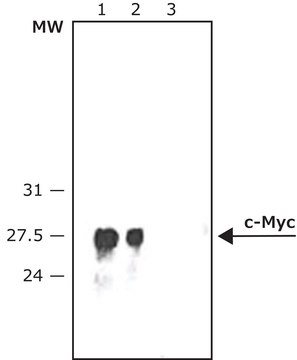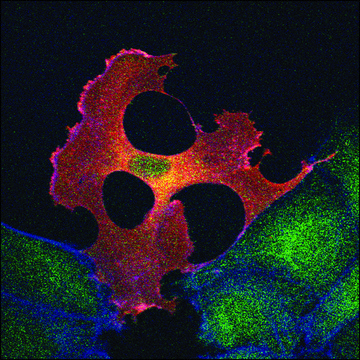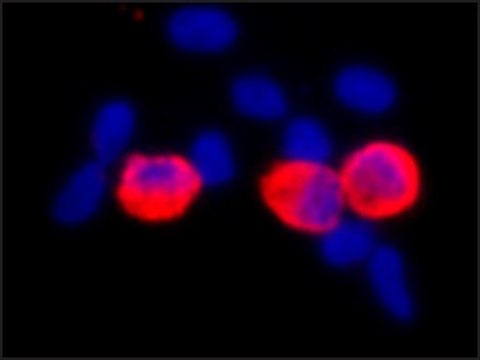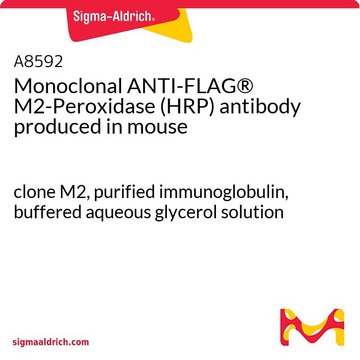推荐产品
生物来源
mouse
质量水平
偶联物
peroxidase conjugate
抗体形式
purified from hybridoma cell culture
抗体产品类型
primary antibodies
克隆
9E10, monoclonal
表单
lyophilized powder
种属反应性
human
包装
vial of 100 μL
浓度
~2 mg/mL
技术
immunoblotting: 1:250-1:500 using lysate of HEK-293T cells over expressing c-Myc fusion protein
immunohistochemistry: suitable
同位素/亚型
IgG1
UniProt登记号
运输
dry ice
储存温度
−20°C
靶向翻译后修饰
unmodified
基因信息
human ... MYC(4609)
一般描述
c-Myc单克隆抗体(小鼠IgG1亚型)来源于小鼠骨髓瘤细胞和KLH偶联人p62c-myc蛋白合成多肽免疫的BALB/c小鼠脾细胞融合而产生的9E10杂交瘤细胞。c-Myc是位于人类8号染色体长臂上的原癌基因。编码蛋白含有N端转录激活结构域。人c-Myc原癌基因是在几种致白血病逆转录病毒中发现的禽类v-Myc基因的人细胞同源物。
特异性
调宁蛋白单克隆抗体特异性识别平滑肌调宁蛋白(Calponin)。
免疫原
人 p62c-myc 蛋白的合成肽。
应用
小鼠抗c-Myc-过氧化物酶单克隆抗体可用于免疫印迹和免疫组化技术。
生化/生理作用
c-Myc是一种参与细胞生长、增殖、分化和凋亡调节的转录因子。与DNA复制、RNA剪接或转录有关。该基因过表达与多种人类癌症的发生发展有关。
外形
以冻干粉形式提供。用0.1 mL蒸馏水重悬(reconstitution)至∼ 2 mg/mL的最终抗体浓度,溶液为含有1% BSA、2.5% 海藻糖和0.05% MIT的0.01M 磷酸钠缓冲液
储存及稳定性
冻干产品2–8 °C储存。重新配制(reconstitution)后,若要延长储存时间,请以等分试样储存于-20°C。应避免反复冻融循环。重新配制(reconstitution)后如需继续使用,可在2-8 °C下储存至多一月。稀释的工作溶液在12小时后应当被丢弃。
免责声明
除非我们的产品目录另有说明,否则我们的产品仅供研究使用,不得用于任何其他目的,包括但不限于未经授权的商业用途、体外诊断用途、离体或体内治疗用途或任何类型的消费或应用于人类或动物。
未找到合适的产品?
试试我们的产品选型工具.
警示用语:
Warning
危险声明
危险分类
Skin Sens. 1
储存分类代码
13 - Non Combustible Solids
WGK
WGK 2
闪点(°F)
Not applicable
闪点(°C)
Not applicable
法规信息
常规特殊物品
含少量动物源组分生物产品
历史批次信息供参考:
分析证书(COA)
Lot/Batch Number
The c-Myc target gene network
Dang CV, et al.
Seminars in Cancer Biology, 16(4), 253-264 (2006)
Prognostic Value of c-Myc Immunohistochemical Expression in Muscle Invasive Urothelial Carcinoma of the Urinary Bladder: A Retrospective Study
Elwy AE, et al.
Asian Pacific Journal of Cancer Prevention, 20(12), 3735-3735 (2019)
Lin Zhu et al.
eLife, 12 (2024-01-29)
Viral inclusion bodies (IBs) commonly form during the replication of Ebola virus (EBOV) in infected cells, but their role in viral immune evasion has rarely been explored. Here, we found that interferon regulatory factor 3 (IRF3), but not TANK-binding kinase
Hainan Liu et al.
Journal of virology, 96(12), e0041222-e0041222 (2022-06-03)
SARS-CoV-2 is the causative agent of the ongoing pandemic of coronavirus disease 2019 (COVID-19) and poses a significant threat to global health. N protein (NP), which is a major pathogenic protein among betacoronaviruses, binds to the viral RNA genome to
Tong Zheng et al.
Journal of virology, 98(4), e0156523-e0156523 (2024-03-06)
The COVID-19 pandemic caused by severe acute respiratory syndrome coronavirus 2 (SARS-CoV-2) has posed a worldwide threat in the past 3 years. Although it has been widely and intensively investigated, the mechanism underlying the coronavirus-host interaction requires further elucidation, which
我们的科学家团队拥有各种研究领域经验,包括生命科学、材料科学、化学合成、色谱、分析及许多其他领域.
联系技术服务部门








